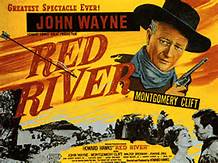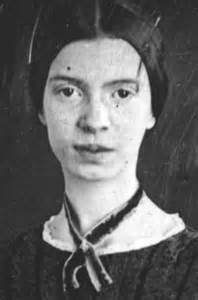(for Part 1, scroll down past part the second))
Stanza the Second
 I have not forgotten. Rubicon. Here’s the rub. The Red River, which is also a Texas border and part of the legendary geography of Old West cattle drives, for those trying to follow my digressions as if . . . never mind. Red River is a designated cinema treasure, as Robert Osborne tells us, and it’s about betrayal, vengeance, private enterprise and violence, all with requisite dust, livestock and rubes. Women appear and speak, even dispute. They do matter, in a Hawksish way, but it’s a man’s man’s movie, a hawks’, not much on the “then the letting go” front. Caesar deciding to take the reins from the self-satisfied and corrupt magistrates, to trump them, by hook or pilum. Tough steer magnate Tom (big John) Dunson (do I hear a “dunce” in there?) determined to drive the 10,000 head to Missouri for the big lollapalooza bonanza, instead of the safer, closer Abilene payoff. Like Austin and Mabel willing to risk all domestic harmony for a whole gaggle of folks (though A. D.’s wife Susan Gilbert Dickinson was already low-dosing on arsenic for some “mysterious illness”) for the pleasures of wrestling out of all that Victorian millinery and making the two-backed beast. (I remember, much later than these simple discoveries, reading one of Mabel’s letters in which she mentioned the need in Japan for a western lady always to be armed with a button hook, as it was always necessary to remove one’s shoes-of-many-fasteners to visit a temple. This is before Velcro. Old fashioned Cupid was a harsh taskmaster, as was Baedeker.) Hard not to mention in such flights of fancy that A and M called their attempts to procreate “the experiment.” Shades of Dr. Frankenstein.
I have not forgotten. Rubicon. Here’s the rub. The Red River, which is also a Texas border and part of the legendary geography of Old West cattle drives, for those trying to follow my digressions as if . . . never mind. Red River is a designated cinema treasure, as Robert Osborne tells us, and it’s about betrayal, vengeance, private enterprise and violence, all with requisite dust, livestock and rubes. Women appear and speak, even dispute. They do matter, in a Hawksish way, but it’s a man’s man’s movie, a hawks’, not much on the “then the letting go” front. Caesar deciding to take the reins from the self-satisfied and corrupt magistrates, to trump them, by hook or pilum. Tough steer magnate Tom (big John) Dunson (do I hear a “dunce” in there?) determined to drive the 10,000 head to Missouri for the big lollapalooza bonanza, instead of the safer, closer Abilene payoff. Like Austin and Mabel willing to risk all domestic harmony for a whole gaggle of folks (though A. D.’s wife Susan Gilbert Dickinson was already low-dosing on arsenic for some “mysterious illness”) for the pleasures of wrestling out of all that Victorian millinery and making the two-backed beast. (I remember, much later than these simple discoveries, reading one of Mabel’s letters in which she mentioned the need in Japan for a western lady always to be armed with a button hook, as it was always necessary to remove one’s shoes-of-many-fasteners to visit a temple. This is before Velcro. Old fashioned Cupid was a harsh taskmaster, as was Baedeker.) Hard not to mention in such flights of fancy that A and M called their attempts to procreate “the experiment.” Shades of Dr. Frankenstein.
But: Rubicon. The ancients did have a romantic side. Maybe the solicitor/accountant/untrustworthy trustee of Amherst College Austin had other powers and resembled more Dr. Jekyll and Mr. Whatsit. On 9/11, 1882, A escorted M through rain and dusk to the Evergreens, his very own home and hearth, for a perhaps spirited game of whist. En route, they paused, spoke. That night he wrote in his diary the players’ names (including “Ms. Todd,” which is right neigh the German for “death”), weather conditions and some cursive scribble that I can only guess is “stranger lights & hound,” but I must be mistaken and wish someone with better eyes would transcribe it. This I can read: early in the brief entry “not much going on,” but after naming the card party participants, Mabel’s last on the list, a line skipped, and then the single word: Rubicon. Polly Longsworth, in her books Austin and Mabel and The World of Emily Dickinson interprets this trisyllabic ejaculation to mean that A confessed his dark desires to Mabel. (Like to ask her about that possible hound, though.)
But there’s a little more, then a lot more. Mabel also kept a journal, half a page for that day – the weather, the party, a formal reference to Mr. Muttonchops, and then, at the very bottom of the September 11 (-yes-) page, separate, penciled in (probably at a later date, according to Polly, who has seen the genuine article), the word, the red river, the cast die and irreversible decision, if such heart-smitten moments resemble decisions. Added later to perhaps correct a semantic asymmetry between them. The couple also created a charm, the code Amuasbteiln. His name having swallowed hers. They were busy as May bees and seemed to take to deceit. THIS was the love that dare not whisper its name. They were not adequately sly, however, nor could they manage to spring an offspring.![]()
The “lot more” is Longsworth’s excellent 1984 Farrar, Straus, Giroux book Austin and Mabel: The Amherst Affair and Love Letters of Austin Dickinson and Mabel Loomis Todd, plus the later illustrated biography The World of Emily Dickinson, the latter in this matter especially valuable for the images of AD and MLT, especially those which show her eyes, which are mad as a rabid fox’s, and her parlors, which are more museums than spaces for work or sloth. She was a natural-born curator, bless her heart. His story does not end well, by the way, nor does hers. If you want to know why, visit any cemetery; we all end up pretty much the same.
[Some notes:
*Emily D. was called among the neighbors “the myth.”
*She wrote in a letter, I think to Higginson, that her eyes were the color of sherry.
*Whist is bridge without bidding. Nothing ventured . . . no dice.
*First name of the previous owner of my second-or-so-hand-copy of Longworth’s study of the correspondence was – and I hope is – Sherry.]
 But there’s yet a brighter side, at least for me, at least for now. I had made some of these discoveries about the Dickinson family scandal, particularly Longworth’s reprint and discussion of the letters, some time ago, before 1996. I know this simply because, when I first met my wife (it was September, 1996), I had (Eureka!) been prepped by my adventures in reading: one word hammered its dactyl permanently into my spirit, and neither Marion Montgomery (John Wayne’s real moniker), Jeep products nor Julius Caesar could have been further from my fevered mind. What I thought was Rubicon.
But there’s yet a brighter side, at least for me, at least for now. I had made some of these discoveries about the Dickinson family scandal, particularly Longworth’s reprint and discussion of the letters, some time ago, before 1996. I know this simply because, when I first met my wife (it was September, 1996), I had (Eureka!) been prepped by my adventures in reading: one word hammered its dactyl permanently into my spirit, and neither Marion Montgomery (John Wayne’s real moniker), Jeep products nor Julius Caesar could have been further from my fevered mind. What I thought was Rubicon.

